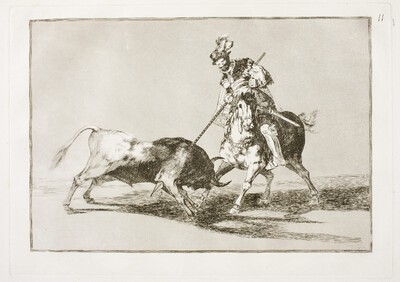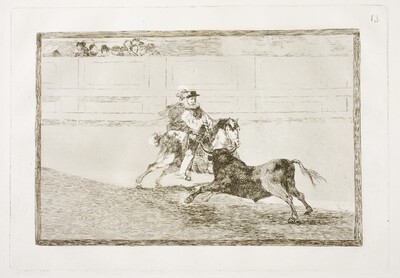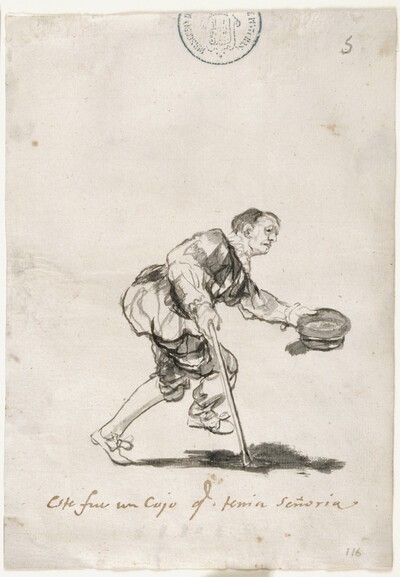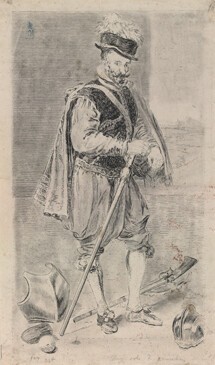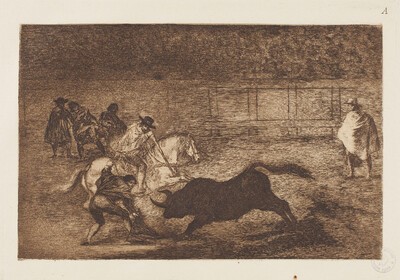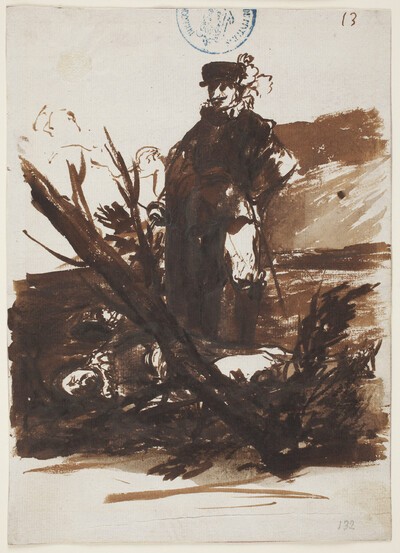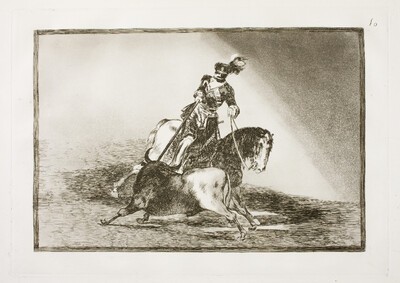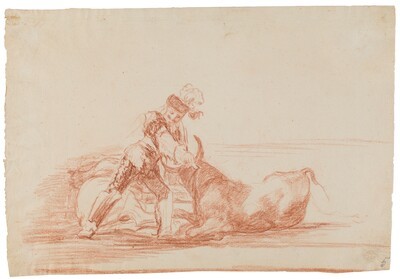- Cronología
- 1814 - 1816
- Dimensiones
- 246 x 352 mm
- Técnica y soporte
- Reconocimiento de la autoría de Goya
- Documented work
- Ficha: realización/revisión
- 01 Oct 2021 / 22 Jun 2023
- Inventario
- -
9 ( (print, upper right-hand corner))
Goya (in mirror and vertical, embossed, lower left-hand corner)
See How the ancient Spaniards hunted bulls on horseback in the countryside
There is a state proof, made before the aquatint and burnisher, in the Museum of Fine Arts, Boston.
The plate is kept at the National Chalcography.
See How the ancient Spaniards hunted bulls on horseback in the countryside
The print is part of the subgroup, composed of four prints, dedicated to the origin and chivalrous nature of bullfighting on horseback (nos. 9-11 and 13). It depicts in a somewhat burlesque manner a gentleman dressed inappropriately for bullfighting, according to the Count of La Viñaza, with a turban adorned with feathers, a short jacket with a sash, narrow trousers and an outlandish boot with large spurs, who has dismounted from his horse and with a somewhat forced pose thrusts his sword into the neck of the bull, which has bent its legs, instyle known as " pawning on foot".In the background, behind the bull, is the horse, badly wounded and unable to get up, which seems to be observing the scene. The background is neutral and without spatial references, worked only with aquatint, which creates an area of light that frames and highlights the figures.
Lafuente Ferrari omments on the print in relation to the preparatory drawing for the same, also entitled Spanish knight kills bull after losing his horse, in which the horse is dead and can barely be seen behind its rider. He also compares the figure of the knight with The Jester Don Juan of Austria, a portrait by Velázquez copied by Goya himself in a print.
Gassier compares the figure of the knight with another that appears throughout the series in different engravings and also in different drawings in various notebooks, such as This was a lame man who had a lordship (C.5) or Conqueror without witnesses (F.13), among others.
Martínez-Novillo relates it to the prints A Spanish Gentleman in the Square Breaking a Fistfight without the Help of the Pimps and A Gentleman in the Square Breaking a Fistfight with the Help of a Pimp ("Bullfighting A"), although in his opinion these represent scenes from the time of Goya and not "historical" ones, an aspect on which there is no agreement among specialists.
-
Grabados y dibujos de Goya en la Biblioteca NacionalBiblioteca NacionalMadrid1946catalogue Elena Páez Ríos
-
Goya en la Biblioteca Nacional. Exposición de grabados y dibujos en el sesquicentenario de su muerteBiblioteca NacionalMadrid1978May - June 1978
-
Grabados de Goya: colección propiedad de la Biblioteca Nacional, que se conserva en su Gabinete deCasa de la Amistad de MoscúMoscow1979exhibition displayed from January 18th to 31st 1979
-
1984
-
Madrid1987
-
Madrid1990
-
Goya grabadorFundación Juan MarchMadrid1994consultant editors Alfonso E. Pérez Sánchez and Julián Gállego, from January 14th to March 20th 1994
-
Goya grabadorMuseo del Grabado Español ContemporáneoMarbella1996from March 8th to May 5th 1996
-
Zaragoza1996
-
Schlaf der Vernunft. Original radierungen von Francisco de GoyaMunich2000
-
Madrid2002
-
Madrid2002
-
Bilbao2012
-
Goya et la modernitéPinacothèque de ParisParís2013from October 11st 2013 to March 16th 2014cat. 25
-
Zaragoza2017
-
1946pp. 177-216, espec. pp. 185 y 191
-
OxfordBruno Cassirer1964vol. II, 1964, p. 322, cat. 212
-
Vie et ouvre de Francisco de GoyaParísOffice du livre1970p. 277, cat. 1165
-
The Changing image: Prints by Francisco GoyaBostonMuseum of Fine Arts1974pp. 216-218, cat. 168-169
-
Goya, toros y torerosMadridMinisterio de Cultura, Comunidad de Madrid1990p. 92, cat. 23
-
MadridCaser-Turner1992pp. 30-31
-
MadridMuseo Nacional del Prado2001pp. 54-55
-
ParísPinacoteca de París2013p. 104

